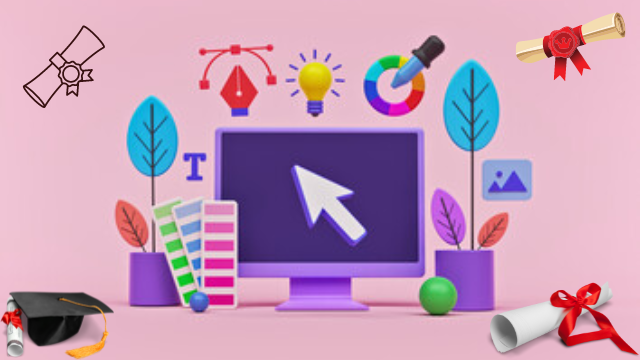Are you ready to unleash your creativity and become a designer in 2024? This article will show you the essential steps to achieve your dream. From mastering graphic design principles to building a strong portfolio, you’ll discover the skills, tools, and strategies needed for success. Learn how to enroll in design courses, work on personal projects, and gain real-world experience. Get ready to embark on an exciting journey and unlock your creative potential as a designer in 2024. Let’s get started!
Speak to a Learning Advisor
To begin your journey to become a designer in 2024, reach out to a Learning Advisor. They will be your guide and confidant in navigating the world of design education. The benefits of working with a Learning Advisor are immense. They can help you choose the right course that aligns with your interests and goals. Whether you’re interested in graphic design, UX design, or any other design field, they can provide you with valuable insights and recommendations.
One of the key advantages of working with a Learning Advisor is the networking opportunities they can provide. They have connections with industry professionals and can introduce you to potential mentors and peers. Networking is essential in the design world, as it can open doors to new opportunities and collaborations.
In addition, a Learning Advisor will emphasize the importance of continuous learning. Design is a field that constantly evolves, and staying updated on the latest trends and technologies is crucial for success. They will encourage you to embrace lifelong learning and explore future trends in design, ensuring that you stay ahead of the curve.
Enroll in a Graphic Design Course
Start your journey to becoming a designer in 2024 by enrolling in a graphic design course. Choosing the right course is crucial to gaining the knowledge and skills you need to succeed in this competitive field. Look for courses that cover a wide range of topics, such as color theory, typography, layout, software, history, UX, and website design. Additionally, finding mentors who can guide you through your learning journey and provide valuable insights is essential.
In addition to theoretical knowledge, gaining hands-on experience is vital for honing your skills. Look for courses that offer practical projects that allow you to apply what you’ve learned in a real-world context. This will not only build your portfolio but also give you a taste of the challenges and opportunities you may encounter in the industry.
Networking events are another valuable resource for aspiring designers. Attend industry events, conferences, and workshops to connect with professionals, learn about industry trends and advancements, and expand your network. These events provide opportunities to meet potential mentors, collaborators, and even employers.
Learn Graphic Design Principles
Begin by understanding the fundamental principles of graphic design. To truly excel in this field, it is crucial to have a solid grasp of design theory, color psychology, typography trends, composition techniques, and visual storytelling. These elements will serve as the foundation for creating visually appealing and effective designs that resonate with your audience. Design theory will provide you with an understanding of how to effectively communicate through visuals, while color psychology will help you evoke specific emotions and create impactful designs. Keeping up with typography trends will ensure that your designs are contemporary and visually appealing, while composition techniques will guide you in creating balanced and visually pleasing layouts. Lastly, visual storytelling will enable you to convey messages and narratives through your designs, making them more engaging and memorable. By mastering these principles, you will be well-equipped to create stunning and impactful designs that captivate and resonate with your audience.
Learn Key Graphic Design Tools
Mastering key graphic design tools is essential for becoming a designer in 2024. To enhance your design skills, it is crucial to explore and utilize graphic design software. One of the industry-standard software is Adobe Creative Cloud, which includes tools like Adobe Photoshop, Illustrator, and InDesign. These tools are considered essential for graphic designers and mastering them will greatly benefit your career.
By utilizing Adobe tools, you can create stunning visuals, manipulate images, and design layouts with ease. These software offer a wide range of features and capabilities that allow you to bring your creative ideas to life. Additionally, there are plenty of user guides and training resources available to help you learn and master these tools.
Exploring other design software is also important as it can provide you with a broader skill set. There are various design software available in the market that cater to different design needs and preferences. By familiarizing yourself with these software, you can expand your capabilities as a designer and offer more diverse services to clients.
Work on Personal Projects
To develop your skills as a designer in 2024, focus on working on personal projects. This will not only help you enhance your creative abilities but also showcase your unique style and expertise. Here are some key points to consider when it comes to personal projects:
- Personal project ideas: Explore different design areas like logo creation, website design, or social media graphics. Use your imagination and experiment with different styles and techniques.
- Benefits of personal projects: Personal projects allow you to work on your own terms, without any client restrictions. They give you the freedom to explore new ideas and push your creative boundaries.
- Finding inspiration for personal projects: Look for inspiration in everyday life, nature, art, and design trends. Keep a sketchbook to jot down ideas and gather visual references.
- Challenges of personal projects: Personal projects can be challenging as you have to manage your own time and motivation. It can be difficult to stay focused and disciplined, but the rewards are worth it.
- Showcasing personal projects: Create a portfolio to showcase your personal projects. Use online platforms like Dribbble, Behance, or your own website to share your work with a wider audience.
Develop a Portfolio
How can you effectively showcase your skills as a designer in 2024? Developing a portfolio is a crucial step in demonstrating your creativity, style, and skills to potential clients or employers. A well-curated portfolio can act as a visual representation of your abilities and help you stand out in a competitive industry.
To create a compelling portfolio, consider the following:
- Showcase a variety of projects: Include a diverse range of work that highlights your versatility and expertise. Whether it’s logo design, website development, or print materials, demonstrate your ability to tackle different design challenges.
- Refine your style: Use your portfolio to showcase your unique design aesthetic. Develop a consistent visual language that reflects your personal brand and sets you apart from others in the field.
- Highlight your experience: Include projects that demonstrate your experience and expertise. Whether it’s freelance work, internships, or personal projects, showcase your ability to deliver high-quality designs and meet client expectations.
Understand Design Theory
Why is it important to have a solid understanding of design theory as a designer in 2024?
Understanding design theory is crucial for designers in 2024 because it allows you to create visually appealing and effective designs that resonate with your target audience. Here are five key reasons why a solid understanding of design theory is essential:
- Understanding color psychology: Design theory helps you grasp the impact of colors on emotions and how to use them strategically in your designs to evoke specific responses.
- Exploring design aesthetics: By understanding design theory, you can explore different aesthetics, including minimalist, retro, or futuristic, and choose the most appropriate style for your projects.
- Applying design principles: Design theory provides you with a set of principles, such as balance, contrast, and hierarchy, that guide your design decisions and ensure that your creations are visually cohesive and harmonious.
- Analyzing visual communication: Design theory helps you analyze and understand how visuals communicate messages, allowing you to effectively convey your intended meaning to your audience.
- Incorporating user experience: Design theory helps you consider the user’s perspective, ensuring that your designs are user-friendly, intuitive, and provide a seamless experience.
Master Design Elements
Understanding the design elements is essential for mastering the art of graphic design in 2024. Balancing colors is a crucial skill that allows you to create visually pleasing compositions. By understanding color theory and the psychology behind different colors, you can evoke specific emotions and create impactful designs. Typography techniques play a significant role in effective communication. Choosing the right fonts, sizes, and spacing can enhance readability and convey the intended message. Designing for emotions involves using visual elements to elicit specific feelings in your audience. By carefully selecting colors, typography, and imagery, you can create designs that evoke joy, excitement, or even nostalgia. Incorporating texture adds depth and visual interest to your designs. Whether it’s through the use of actual textures or creating the illusion of texture with digital tools, incorporating this element can make your designs more engaging. Creating visual hierarchy is essential for guiding the viewer’s attention and organizing information effectively. By utilizing techniques such as size, color, and placement, you can ensure that the most important elements stand out and convey your message clearly. Mastering these design elements will allow you to create compelling and impactful designs that resonate with your audience.
Get Certified as a UX Designer
To become a certified UX Designer, you will need to undergo specific training and earn a recognized certification. Certification options in UX design are available to help you gain the skills and knowledge needed to excel in this field. Here are some key points to consider:
- Job prospects: The demand for UX designers is on the rise, with a projected growth rate of 14% from 2018 to 2028. This indicates a strong industry demand for professionals in this field.
- UX design trends: Staying up-to-date with the latest trends in UX design is crucial. This includes understanding user behavior, mobile design, accessibility, and emerging technologies like voice user interfaces and virtual reality.
- Industry demand: As companies continue to recognize the importance of user-centered design, the demand for UX designers across various industries is increasing. This provides ample opportunities for certified professionals.
- Skills required: To succeed as a UX designer, you need a combination of technical and soft skills. These include proficiency in user research, wireframing, prototyping, information architecture, and usability testing. Additionally, strong communication, problem-solving, and collaboration skills are essential.
Explore Career Opportunities
Now that you have gained the necessary skills and certifications, it’s time to explore the exciting career opportunities available in the field of design. As a designer, you will have a range of job prospects to choose from. Whether you want to work in a creative agency, a tech company, or even start your own freelance business, the options are endless.
When it comes to salary expectations, the design industry offers competitive compensation. Salaries can vary depending on factors such as experience, specialization, and location. Keep in mind that industry trends play a significant role in shaping the demand and earning potential for designers. Staying updated on the latest design trends and technologies will give you an edge in the job market.
Speaking of freelance opportunities, the design field is well-suited for freelancers. Many companies and individuals are in constant need of design services on a project basis. Freelancing gives you the flexibility to work on multiple projects, collaborate with different clients, and set your own rates.
Lastly, specialization options in design are abundant. Whether you want to focus on web design, user experience, branding, or illustration, there is a niche for every interest. By specializing in a specific area, you can become an expert in your field and open up even more career opportunities.
Build a Professional Network
Start connecting with fellow designers and industry professionals to build a strong professional network. Building a network is essential for your growth as a designer and can open doors to new opportunities. Here are some effective ways to build your professional network:
- Attend networking events: Networking events offer a great opportunity to meet and connect with other designers and industry professionals. Look for events in your area and make an effort to attend them.
- Utilize online platforms: Online platforms such as LinkedIn, Behance, and Dribbble are excellent resources for connecting with fellow designers and showcasing your work. Join relevant groups and engage in discussions to expand your network.
- Explore freelance job websites: Freelance job websites like Upwork and Freelancer can help you connect with potential clients and build relationships within the industry. Take on freelance projects to gain experience and expand your network.
- Tap into personal networks: Reach out to friends, family, and colleagues who may have connections in the design industry. They can provide valuable introductions and recommendations.
- Consider graphic design internships: Internships are a great way to gain practical experience and network with professionals in the field. Look for internships at design agencies or companies that align with your interests.
Stay Updated and Continuously Learn
Continuously learning and staying updated is crucial for designers to thrive in the ever-evolving industry. As a designer, it is essential to prioritize continuous learning and skill enhancement in order to stay relevant and competitive. The field of design is constantly evolving, with new trends and technologies emerging all the time. By staying updated on industry trends, you can ensure that your skills and knowledge are up to date.
One way to stay updated is by regularly engaging in professional development opportunities. Attend design conferences, workshops, and webinars to gain insights into the latest practices and techniques. Additionally, follow industry leaders and influencers on social media platforms to stay informed about current design trends and advancements.
Another important aspect of staying updated is continuous learning. Take advantage of online courses, tutorials, and resources to enhance your skills and expand your knowledge. Invest time in learning new design tools and software to stay ahead of the curve. By continuously learning and improving your skills, you can ensure that you are equipped to tackle new challenges and deliver high-quality designs.
Read this next:




